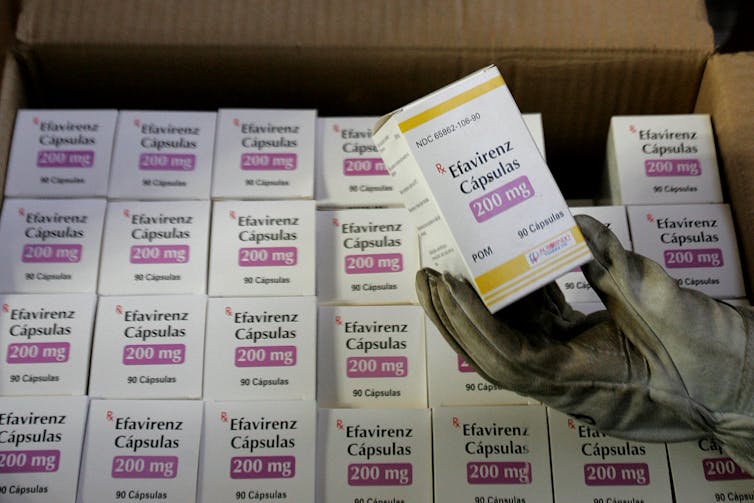
The most common form of dementia, Alzheimer’s, is a progressive, life limiting, neurodegenerative condition, which damages and destroys parts of the nervous system, especially the brain, over time.
Women are most likely to be affected. They make up two-thirds of people with Alzheimer’s. It is not yet understood why women have greater risk of developing the disease – but there does seem to be a link with the menopause.
Our latest research has examined this link and it suggests that the activation of a brain protein called CYP46A1, using an anti-HIV drug, could help protect women from developing disease.
Women transition into menopause, usually between 45 and 55 years of age. Menopause is caused by loss of oestrogen, a hormone essential for maintaining brain health as well as learning and memory skills.
Early menopause, with onset before 45 years, is a risk factor for memory loss and for developing Alzheimer’s disease later in life.
Research suggests that women who experience early menopause who go on to get Alzheimer’s disease have higher levels of a protein called tau in their brain, which is a hallmark of the disease. Tau is a protein that stabilises neurons – the nerve cells that send messages all over your body to allow you to do everything from breathing to talking, eating, walking, and thinking. In people with Alzheimer’s, tau forms toxic tangles, which contribute to the deterioration of brain functions and memory loss.
Activating brain protein CYP46A1
Our study shows that activation of a brain protein called CYP46A1 could protect women from developing Alzheimer’s disease.
The main function of this protein in the brain is to get rid of excess cholesterol by transforming it into a cholesterol product called 24S-hydroxycholesterol (24SOH). When CYP46A1 levels are increased in the brains of mice, also heightening the production of 24SOH, females present healthier neurons and higher oestrogen activity in the hippocampus – the brain region essential for memory.
The female mice with high CYP46A1 levels showed enhanced memory capacities. Just like humans, when mice get old their memory worsens compared to young mice, and the same is true for menopausal mice compared to non-menopausal mice. Activation of CYP46A1 counteracted memory loss both during aging and during menopause – but only in the female mice.
In male mice, activation of CYP46A1 led instead to worsening memory and accumulation of the male hormone di-hydro-testosterone in their brains.
To understand better how the CYP46A1 protein could have different effects in male and female mice, we grew neurons in culture (on plastic plates in the lab) and treated them with the CYP46A1 product, 24SOH.
In these neurons, 24SOH increased hormone activity, especially oestrogen. We found that increasing oestrogen activity develops healthier and better functioning neurons, explaining the protective effects of the hormone in female mice. However, the male mice did not benefit in the same way because high levels of dihydrotestosterone blocked the positive effects of oestrogen.
Results from mice were supported with studies in people with Alzheimer’s disease. In the human study, 24SOH was measured in the cerebrospinal fluid (the liquid around the brain and spinal cord) of patients from Karolinska Hospital, Sweden. Higher 24SOH levels corresponded to lower levels of Alzheimer’s pathological markers like tau – but only in women.
This suggests that the possible protective effect of high levels of CYP46A1 and 24SOH on Alzheimer’s disease is exclusively for women.
Anti-HIV drug helpful for Alzheimer’s
Previous research has shown that CYP46A1 can be activated by low doses of the commercial anti-HIV drug Efavirenz. Efavirenz has been proposed as Alzheimer’s therapy because lab studies showed beneficial effects against tau and amyloid plaques (where proteins clump together and disrupt cell function), which is known to accumulate in the brains of people with Alzheimer’s.
But the results from our study suggest different effects of CYP46A1 activation in men and women – with beneficial effects prominently in women.

EVARISTO SA/AFP via Getty Images
CYP46A1 activators like Efavirenz may offer a new therapeutic approach to promote oestrogen-mediated brain protection in women at risk of Alzheimer’s disease – women with early menopause, for example.
This approach is different from hormone replacement therapies (HRT), which have yielded variable results so far. The use of HRT seems to reduce the risk of women developing Alzheimer’s disease – but only if given at the time of menopause symptoms. There seems to be no protective effect if given after menopause – and HRT is controversial after being linked to a higher risk of cancer.
New possibilities of increasing oestrogen activity in the brains of women, then, are welcome – and have the potential to become preventative therapy against devastating neurodegenerative diseases like Alzheimer’s.

